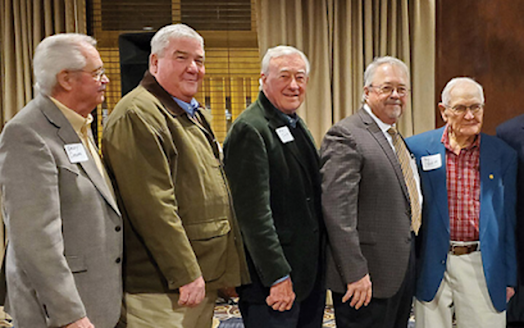Dr. Ron Smith, Auburn University.
This article was originally posted in Cotton Farming Magazine (June 2022).
Fifty Years Of Evolution In Cotton Insect Control — 1971-2021.
It has been quite a journey to have been a part of the most
evolutionary period in cotton insects. I began my career as part of the new
U.S. Department of Agriculture-Extension cotton IPM educational initiative in
1972 when boll weevils were the dominant cotton insect in Alabama.
The goal of the program was to increase awareness of a
management approach to controlling cotton pests, a program which incorporated
scouting and economic thresholds. It has become widely recognized as integrated
pest management (IPM).
Organophosphates
During the mid-1970s, our primary cotton insecticide was the
organophosphate class of chemistry — products such as methyl parathion and
Guthion, which were characterized by fast-acting activity but short residual.
In addition, most chemicals in this class had acute human and mammalian
toxicity.
The phosphate chemistry had excellent activity on the boll
weevil but brought resistance in tobacco budworm and secondary pests, such as
spider mites and whiteflies. Heavy use of phosphate insecticides also caused
major problems with delayed maturity of the crop. This problem was so
pronounced that a special session was added to the January 1976 Beltwide Cotton
Research and Control Conference.
Introduction Of Pyrethroids
In 1976, the pyrethroid class of chemistry became available,
initially under an Environmental Protection Agency-issued emergency use permit
(EUP). In 1978, pyrethroid insecticides (Ambush, Pounce and Pydrin) received
full but conditional registration and became the major player in cotton insect
control for the next decade.
For several years, pyrethroids were highly effective on most
all cotton insects. Insect losses were very low, yields reached higher plateaus
and maturity issues disappeared. Due to extended residual from pyrethroids,
insecticide application intervals for boll weevils could be extended from five
to seven days.
However, during the decade of the 1980s, tobacco budworms
became resistant to the pyrethroid class of chemistry in some areas of the
Cotton Belt.
Boll Weevil Eradication
After more than a decade of development, comprehensive plans
to eradicate the boll weevil were finalized in the early 1980s. One of the
driving forces for eradication were concerns that boll weevils might develop
resistance to the organophosphate chemistry, a possibility which would have
wrecked the U.S. cotton industry.

The Boll Weevil Eradication Program began in northeastern
North Carolina in the early 1980s. In the fall of 1986, the eradication effort
reached Alabama, and by the summer of 1995, no economic losses to the boll
weevil could be found anywhere in the state.
During the active eradication program period (1986-1995),
insecticide-resistant tobacco budworms and impossible-to-control beet armyworms
caused yield losses beyond anything ever observed or previously recorded.
Bt Varieties Commercialized
At the end of the 1995 season — given resistance to tobacco
budworms — the outlook for the future of cotton production in Alabama was
bleak. Fortunately, genetically altered Bt (Bollgard) cotton
varieties, which had been evaluated for the previous four seasons, were
commercialized.
Word was spoken that growers would never have to treat for
worms again. This proved to be incorrect when in late July 1996, news of
bollworm escapes in the Brazos River area of Central Texas spread across the
Cotton Belt.
Bug Complex Threatens
It was during this low-spray environment that the bug
complex became more damaging. In north Alabama and the Mid-South states, the
tarnished plant bug had to be monitored and managed more closely. In central
and south Alabama, as well as the remainder of the Coastal Plains of the
southeastern United States, stink bugs became the dominant economic insect.
By the time better stink bug management was adopted, single Bt gene Bollgard technology began to lose its effectiveness and escape bollworms were more widespread. Experts had warned this would happen. The single Bt gene was nearly 100% effective on tobacco budworm but considerably less effective on the bollworm species.
Anticipating this, Monsanto had begun work on stacking a
second Bt gene, which was commercialized in 2009 and reduced
the escape bollworm problems by about 90%. It was followed by Bollgard III in
2018. WideStrike from Dow AgroSciences with two Bt genes was
introduced in PhytoGen varieties in 2005 and was followed by the third gene
(WideStrike 3) in 2014.
The diamide chemistry developed by Dupont is now available
and highly effective on most worm species when applied timely (small larvae) or
in the egg stage. What would have been a significant development had it not
been for the introduction of Bt technology back in 1996, was
the introduction (1996-98) of spinosad (Tracer) chemistry by Dow AgroSciences.
Sucking Pests, Bug Complex
More recent years of cotton insect control have been
dominated by the emergence of sucking pests, such as aphids, spider mites,
thrips and whiteflies (silverleaf), and the bug complex — plant bugs, stink
bugs and leaf-footed bugs.
Several insecticides targeted for the bug complex give limited control of sucking pests or escape caterpillars. Tankmixes of two or more insecticides are again often necessary.
Staying Ahead Of Resistance
Our future may be described as a “stay ahead of resistance”
in the decades ahead. Resistance issues are present today in the following
species: thrips, plant bugs, bollworms, spider mites, aphids and possibly other
species.
The greatest challenge in entomology is staying ahead of
resistance and managing sporadic pests such as slugs, snails, cutworms,
grasshoppers, three-cornered alfalfa hoppers, leaf-footed bugs and others.
Reduced tillage has been a great advancement. However, this practice has
created numerous cracks that are being filled by sporadic pests that require
management inputs.
In summary, the past 50 years of cotton production and insect management have evolved in many, and in some instances, unexpected ways. What an evolution and what a ride for an Extension entomologist over the past five decades.





